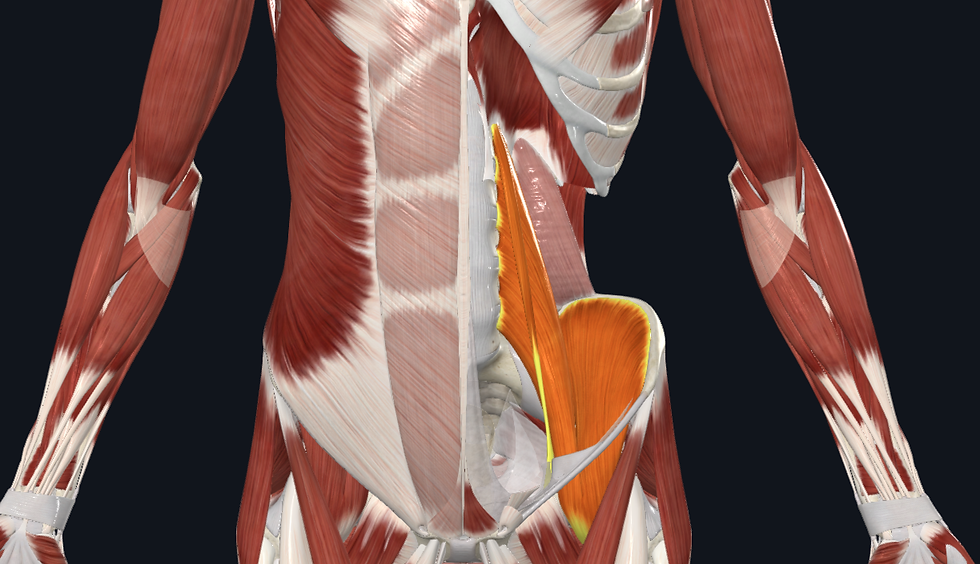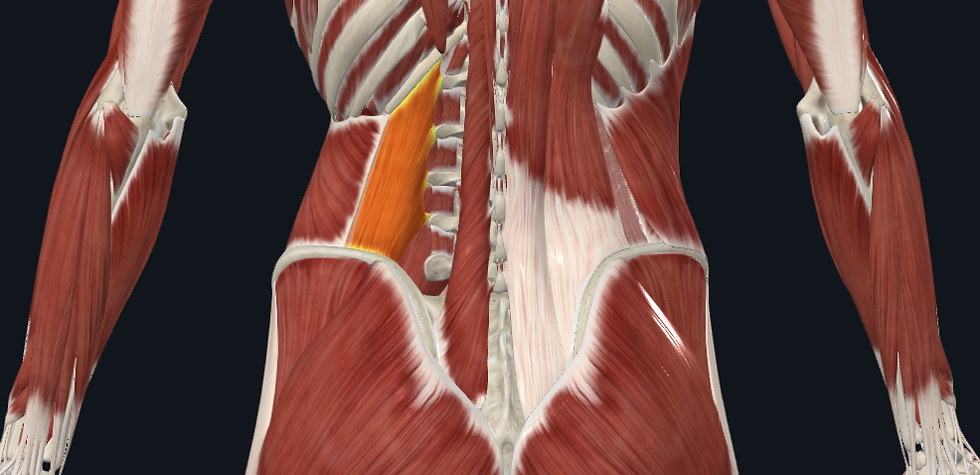Behind the Muscle Pain Part 1: The Psoas Muscle
- Kyle Conatser
- Jul 19
- 4 min read
Updated: Jul 27
Chronic lower back pain is a common issue that affects millions of people globally. Among the various muscles contributing to this discomfort, the psoas muscle has gained significant attention. In this first installment of a three-part series, we will explore the anatomy, function, and connection between the psoas muscle and chronic lower back pain.
What is the Psoas Muscle?
The psoas muscle, often called the "hip flexor," is one of the most important muscles in the body. It is located deep within the abdomen and connects the lumbar spine to the pelvis. The psoas comprises two parts: the psoas major and the psoas minor. It plays a crucial role in various bodily functions such as mobility and posture.
The significance of the psoas muscle goes beyond its location; it impacts other muscle groups and interacts closely with the lumbar spine. When the psoas functions well, it supports hip flexion and helps maintain balance. However, when it becomes tight or shortened—often due to injury, poor posture, or prolonged sitting—it may contribute to lower back pain. For instance, research has shown that about 80% of people experience lower back pain at some point, and dysfunctional psoas muscles could be a contributing factor.

The Function of the Psoas Muscle
The psoas muscle serves several essential functions for everyday movement. Its primary role is to facilitate hip flexion, allowing actions such as walking, running, and climbing stairs. For example, lifting your legs toward your torso activates the psoas. This movement is fundamental to maintaining an active lifestyle.
Additionally, the psoas stabilizes the spine by maintaining proper alignment, connecting the spine to the pelvis. When functioning correctly, it positively impacts posture and overall body mechanics. However, tightness or weakness in the psoas can lead to compensatory muscle patterns that may worsen lower back pain. Studies show that individuals with chronic back pain often exhibit unusual patterns that may be traced back to psoas dysfunction.
Connection Between the Psoas Muscle and Chronic Lower Back Pain
Numerous studies highlight the link between a dysfunctional psoas muscle and chronic lower back pain. Research indicates that persistent tension in the psoas can lead to an anterior pelvic tilt, altering spinal curvature and causing discomfort. Tightness in the psoas can also propagate through interconnected muscle chains, further contributing to lower back pain.
A significant factor in psoas muscle dysfunction is prolonged sitting. Many people today spend over eight hours a day at desks, which can lead to the psoas tightening and shortening. This tightness often extends to adjacent muscle groups, amplifying lower back pain. A study in the Journal of Orthopaedic & Sports Physical Therapy found that individuals with chronic lower back pain demonstrate increased psoas muscle tightness, revealing its critical role in their discomfort.

Recognizing Symptoms
Recognizing symptoms connected to psoas muscle dysfunction is essential in managing chronic lower back pain. Common symptoms include:
Tightness or soreness in the lower back and hip area
Difficulty standing up straight after sitting for extended periods
Pain that radiates from the lower back to the groin or thighs
Pain when lifting your knees up while in a seated position
If these symptoms resonate with you, reach out to us and schedule an appointment for Neural Reset Therapy. Early intervention can help prevent further complications and ease discomfort significantly.
Therapeutic Approaches to Relieve Psoas Muscle Tension
Addressing psoas muscle dysfunction is crucial for alleviating chronic lower back pain. Various therapeutic approaches can enhance flexibility, strength, and overall muscle health. One particularly effective method is Neural Reset Therapy (NRT), which targets muscle tension and promotes immediate relaxation. Consider these recommendations:
Neural Reset Therapy: NRT is an innovative approach that focuses on resetting the nervous system's response to muscle tension. By utilizing specific techniques, NRT can effectively and immediately relieve psoas muscle tension and restore normal function. Many individuals report significant improvements in flexibility and pain reduction in just the first session.
Stretching and Strengthening Exercises: Incorporating targeted stretches can relieve tightness. Effective exercises include lunging hip flexor stretches and seated psoas stretches. For example, performing hip flexor stretches for just a few minutes daily can improve flexibility and reduce tension.
Postural Training: Being aware of and correcting your posture can reduce strain on the psoas, especially for those who sit for long hours. Simple adjustments, such as using ergonomic chairs and following proper postural guidelines, can make a significant difference.
Integrative Modalities: Practices like yoga and Pilates promote psoas flexibility and strengthen surrounding muscles, addressing imbalances contributing to discomfort. Even a weekly class can enhance overall muscle health and reduce pain.
Final Thoughts
The psoas muscle plays a key role in the mechanics of the body, especially concerning chronic lower back pain. Understanding its function and how it affects posture and movement is vital for effective pain management.
In the upcoming parts of this series, we will explore other muscles contributing to chronic pain, offering a comprehensive overview for those experiencing back, neck, shoulder pain, and much more. By integrating insights from this series with practical strategies, individuals can embark on a journey toward improved back health.
As we continue to explore this topic, remember that knowing your body is crucial in managing and overcoming pain. If you're dealing with chronic muscle pain, reach out and schedule an appointment today!





Comments